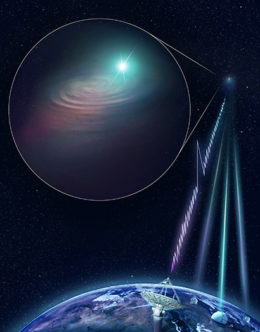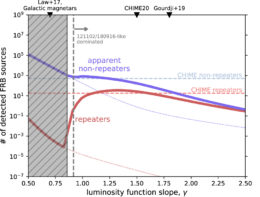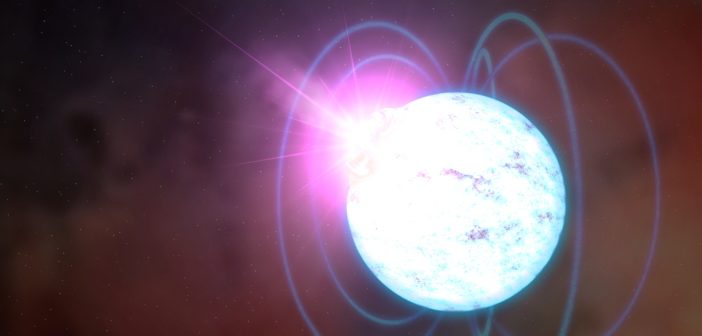Have we recently spotted the first equivalent of a fast radio burst (FRB) — a mysterious and brief extragalactic flash of radio emission — in our own galaxy? Some astronomers think so, and argue that the new discovery solidifies the connection between these exotic radio bursts and powerfully magnetized neutron stars.
Origin of a Burst

Artist’s impression of telescopes observing an extragalactic fast radio burst. [CSIRO/Andrew Howells]
There’s plenty of evidence pointing to magnetars as the source of FRBs, from polarization measurements that suggest FRB sources are strongly magnetized, to localizations of several FRBs to star-forming regions typical of magnetar environments. And some magnetars, known as soft gamma-ray repeaters (SGRs), emit repeated high-energy flares and bursts across their lifetime — another sign of volatility that could tie into the FRB picture.
But there’s a major challenge to the magnetar model for FRBs: we’ve never observed radio emission remotely similar to an FRB coming from a magnetar in our own galaxy.
…that is, until now.
A Missing Link Found?
In a new study led by Sandro Mereghetti (INAF, Italy), scientists have reported the detection of a series of bright X-ray bursts from the magnetar SGR 1935+2154 using the International Gamma-Ray Astrophysics Laboratory (INTEGRAL) spacecraft.

The X-ray light curve from INTEGRAL (black line) is shown here with the positions of the associated radio pulses (orange line) marked for comparison. The inset box shows the brightest part of the burst. Click to enlarge. [Mereghetti et al. 2020]
The radio burst exhibits similar structure to the associated X-ray burst from the magnetar, occurred at roughly the same time, and is within a factor of 10 of the energy of some extragalactic FRBs. These clues strongly suggest that SGR 1935+2154’s outburst may be the missing link that connects magnetars with FRBs.
Pinpointing Production
Can we use these new observations of SGR 1935+2154 to narrow down models of FRB production?

The existence of a second, rare population of magnetars with stronger magnetic fields and higher activity levels could explain a number of properties of the FRBs we’ve observed. As an example, the observed rates of repeating and non-repeating FRBs can be reproduced with the authors’ two-population model. [Adapted from Margalit et al. 2020]
Margalit and collaborators also use the radio and X-ray observations from SGR 1935+2154 to evaluate specific magnetar emission mechanisms, providing constraints on models of how these energetic flashes are produced.
SGR 1935+2154 may have more X-ray and radio activity in store for us in the future, so you can bet we’ll be keeping an eye on it. With any luck, upcoming observations will help us to further address the mystery of FRBs — right here in our own galaxy.
Citation
“INTEGRAL Discovery of a Burst with Associated Radio Emission from the Magnetar SGR 1935+2154,” S. Mereghetti et al 2020 ApJL 898 L29. doi:10.3847/2041-8213/aba2cf
“Implications of a Fast Radio Burst from a Galactic Magnetar,” Ben Margalit et al 2020 ApJL 899 L27. doi:10.3847/2041-8213/abac57


4 Comments
Pingback: From AAS NOVA: “An Update on Fast Radio Bursts: New Discovery in Our Own Galaxy” | sciencesprings
Pingback: Different Views of a Fast Radio Burst
Pingback: From AAS NOVA: “Different Views of a Fast Radio Burst” | sciencesprings
Pingback: Featured Image: Blob Ejection May Cause Magnetar Bursts